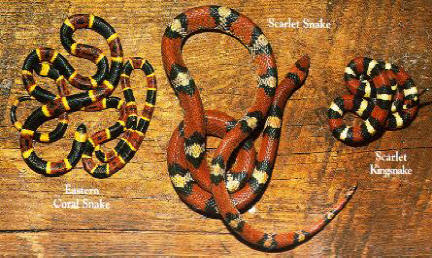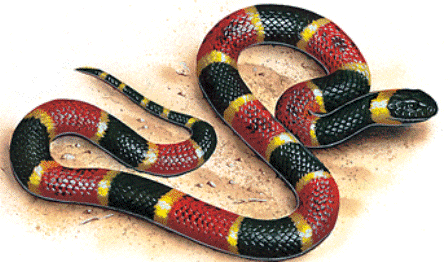Discover Florida Nature
It's time to explore the natural Florida


|
|
|
|
|
 The
legendary and colorfully banded Eastern Coral Snake can be
distinguished from the Scarlet Snake and the Kingsnake by its blunt
black snout and the fact that its red and yellow bands touch each other.
"Red on yellow, kill a fellow" is an old jingle that
most Florida children (and adults) are familiar with. It is a quick way
to know if the snake you see is a deadly coral snake or one if it's
mimics, the Scarlet Kingsnake or the Scarlet Snake. Coral snakes have a
wide black band touching a smaller yellow band, with a third band of red
surrounded on both sides by the yellow bands. The tail is black and
yellow, without any red rings. Another distinguishing feature of the
Eastern Coral Snake is that it's rings go all the way around their body,
although they are not as intense on their bellies. The Scarlet snake has
both a red head and a white belly, two easy features to distinguish the
two. Most coral snakes are less than thirty inches long, averaging
between 20 to 30 inches. The record length for a Coral Snake is 47.5
inches long. Coral Snakes have a variable amount of black pigment in
their red scales. The less black pigment a snake has in it's red scales,
the brighter the snakes colors appear. In snakes that have larger
amounts of black pigment, the red rings usually contain black flecks or
spots. The Eastern Coral Snake's pupils are round. The color pattern of
the young is the same as the adults. The
legendary and colorfully banded Eastern Coral Snake can be
distinguished from the Scarlet Snake and the Kingsnake by its blunt
black snout and the fact that its red and yellow bands touch each other.
"Red on yellow, kill a fellow" is an old jingle that
most Florida children (and adults) are familiar with. It is a quick way
to know if the snake you see is a deadly coral snake or one if it's
mimics, the Scarlet Kingsnake or the Scarlet Snake. Coral snakes have a
wide black band touching a smaller yellow band, with a third band of red
surrounded on both sides by the yellow bands. The tail is black and
yellow, without any red rings. Another distinguishing feature of the
Eastern Coral Snake is that it's rings go all the way around their body,
although they are not as intense on their bellies. The Scarlet snake has
both a red head and a white belly, two easy features to distinguish the
two. Most coral snakes are less than thirty inches long, averaging
between 20 to 30 inches. The record length for a Coral Snake is 47.5
inches long. Coral Snakes have a variable amount of black pigment in
their red scales. The less black pigment a snake has in it's red scales,
the brighter the snakes colors appear. In snakes that have larger
amounts of black pigment, the red rings usually contain black flecks or
spots. The Eastern Coral Snake's pupils are round. The color pattern of
the young is the same as the adults.  The
Coral Snake occurs throughout the entire state of Florida, including the
northern keys. The species extends north to southeastern North Carolina
and west to eastern Texas and northeastern Mexico. This snake occupies a
variety of habitats, from dry, well-drained
flatwoods and
scrub areas to low, wet
hammocks and the borders of swamps. They are quite secretive and are
usually found under debris and in the ground, but occasionally they are
found in the open, and have even been seen climbing the trunks of
live oaks. Good numbers of them
are turned up when pine flatwoods are bulldozed, particularly in south
Florida. Like it's two mimics, the Eastern Coral snake is a seldom seen
burrower that is sometimes found under leaves, in trash piles, or in
rotten logs. The
Coral Snake occurs throughout the entire state of Florida, including the
northern keys. The species extends north to southeastern North Carolina
and west to eastern Texas and northeastern Mexico. This snake occupies a
variety of habitats, from dry, well-drained
flatwoods and
scrub areas to low, wet
hammocks and the borders of swamps. They are quite secretive and are
usually found under debris and in the ground, but occasionally they are
found in the open, and have even been seen climbing the trunks of
live oaks. Good numbers of them
are turned up when pine flatwoods are bulldozed, particularly in south
Florida. Like it's two mimics, the Eastern Coral snake is a seldom seen
burrower that is sometimes found under leaves, in trash piles, or in
rotten logs. Baby snakes emerge from their eggs 7 inches (17.8 centimeters) long and fully venomous. Adults reach about 2 feet (0.6 meters) in length. Average lifespan in the wild is unknown, but they can live up to seven years in captivity. Adult Eastern Coral Snakes eat lizards, frogs, and smaller snakes, including the ringneck snake and other coral snakes. Coral Snakes are related to sea snakes, cobras, and mambas. Like their relatives, the fangs of Coral Snakes are fixed in place and inject very powerful neurotoxin This poison attacks the nervous system, causing paralysis, suffocation or blindness. Despite the potency of it's venom, the Coral Snake is a shy creature and always try to crawl away when confronted. This snake does not coil like a pit viper, and it usually does not strike aggressively unless molested. There are numerous accounts of people innocently playing with coral snakes and not getting bitten. Despite such tales it is foolish to take any chances with this dangerous snake! The Coral Snake has a relatively small mouth and teeth. If it is bothered, restrained or picked up, it usually thrashes wildly and will most likely try to bite. If this snake happens to find a finger, toe or fold of skin, it hangs on tenaciously. It might even get it's teeth locked onto a leg or arm. Two common misconceptions about the Eastern Coral snake are that it's fangs are at the rear of the snakes mouth, and that it must chew on it's victim for sometime before it can inject it's venom. In truth the coral snakes pair of venom injecting fangs are fixed in the front of the snakes mouth, and while the Coral Snake does repeat it's bite in a series of chewing motions, this snake is able to administer a deadly dose of venom immediately! If someone is bitten by a coral snake they need to call 911 immediately. A bite from the notoriously venomous eastern coral snake at first seems anticlimactic. There is little or no pain or swelling at the site of the bite, and other symptoms can be delayed for 12 hours. However, if untreated by antivenin, the neurotoxin begins to disrupt the connections between the brain and the muscles, causing slurred speech, double vision, and muscular paralysis, eventually ending in respiratory or cardiac failure. |
|
|
Advertise | Privacy Statement | Dog Encyclopedia | Video |Contact | Alaska Nature |
|